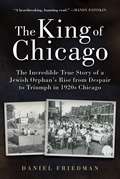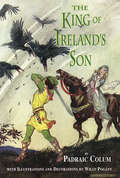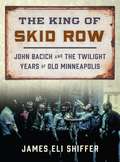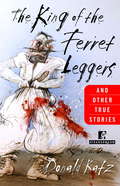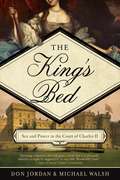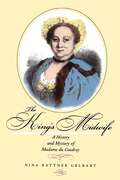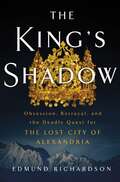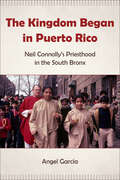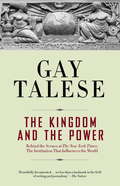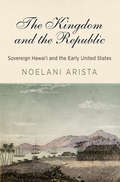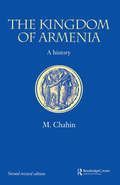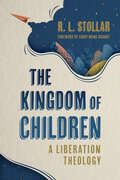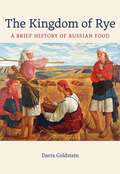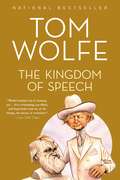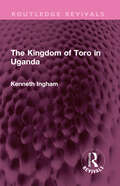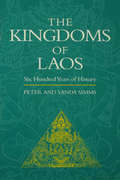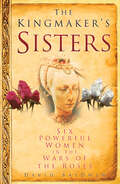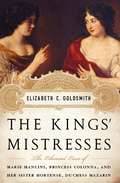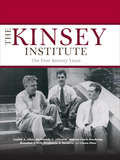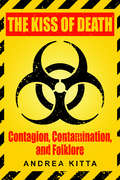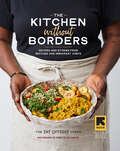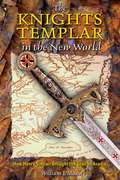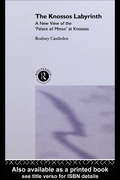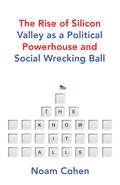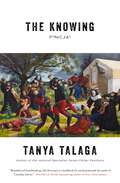- Table View
- List View
The King of Chicago: Memories of My Father
by Daniel Friedman“More than a son’s paean to his father . . . An intergenerational portrait of the quintessential American Jewish family, a rags-to-riches story” (Ethan Michaeli, author of The Defender). The King of Chicago is the story of a father-son relationship as real and hugely loving as that in Philip Roth’s Patrimony. At its heart is a young son who tries furiously to heal his father from a violent childhood inside a Chicago orphanage. The orphanage, the Marks Nathan Home, still stands today on the West Side of Chicago, marked by a tarnished, barely legible plaque. Once home to fourteen thousand Jewish orphans, it is now just another barely remembered relic of a great city. Using original articles from the orphanage newspaper, Friedman attempts to reconstruct and understand his father’s childhood, a time that his father never discussed. Expanding its reach, The King of Chicago becomes a multigenerational saga of Jewish life, moving from a mysterious little man named Kasiel, who arrived in the Port of Baltimore in 1903 with two dollars to his name, to the factory floor of a scrap paper business, a golf course where children played without knowing the rules, and a home on the North Shore among fellow immigrants looking for something better for their children. At its core, this memoir is both a snapshot of immigrant life in Chicago in the early twentieth century and a poignant reminder about the need to never forget who you are and where you come from.
The King of Ireland's Son
by Padraic ColumCompiled by noted Irish author Padraic Colum, this treasury of time-honored tales from the fairy-haunted folklore of the Emerald Isle includes these favorite stories: "Fedelma, the Enchanter's Daughter," "When the King of the Cats Came to King Connal's Dominion," "The Sword of Light and the Unique Tale," "The Town of the Red Castle," "The King of the Land of Mist," "The House of Crom Duv," and "The Spae-Woman."Brimming with sly humor, whimsy and imagination, these delightful tales offer hours of enjoyable reading. Nine full-page illustrations and numerous other decorations by Willy Pogány further enhance the text with a mood of timeless enchantment.
The King of Skid Row: John Bacich and the Twilight Years of Old Minneapolis
by James Eli ShifferThe story of a much different Minneapolis, through the words and photographs of one of its most colorful characters—now in paperback City blue laws drove the liquor trade and its customers—hard-drinking lumberjacks, pensioners, farmhands, and railroad workers—into the oldest quarter of Minneapolis. In the fifty-cent-a-night flophouses of the city&’s Gateway District, they slept in cubicles with ceilings of chicken wire. In rescue missions, preachers and nuns tried to save their souls. Sociology researchers posing as vagrants studied them. And in their midst John Bacich, aka Johnny Rex, who owned a bar, a liquor store, and a cage hotel, documented the gritty neighborhood&’s last days through photographs and film of his clientele. The King of Skid Row follows Johnny Rex into this vanished world that once thrived in the heart of Minneapolis. Drawing on hours of interviews conducted in the three years before Bacich&’s death in 2012, James Eli Shiffer brings to life the eccentric characters and strange events of an American skid row. Supplemented with archival and newspaper research and his own photographs, Bacich&’s stories recreate the violent, alcohol-soaked history of a city best known for its clean, progressive self-image. His life captures the seamy, richly colorful side of the city swept away by a massive urban renewal project in the early 1960s and gives us, in a glimpse of those bygone days, one of Minneapolis&’s most intriguing figures—spinning some of its most enduring and enthralling tales.
The King of the Ferret Leggers and Other True Stories
by Donald KatzThe King of the Ferret Leggers and Other True Stories collects journalist Donald Katz's most fascinating profiles of people whose lives tell us something about business, adventure, sports, politics, culture, and in a brilliant, ancillary way, ourselves. Katz's opening story and the title piece of the book offers a hilarious yet appropriately reverential look at 72-year old Reg Mellor, unparalleled "ferret legging" champion of Yorkshire and the world. Other characters who populate this book include fitness guru Jack LaLanne, legendary entrepreneur Paul Hawken, and master political cartoonist and inspired troublemaker Bill Mauldin. While this collection contains portraits that are varied in scene and tone, their depictions of obsession, delusion, perseverance, creativity, and good-heartedness-the list could go on and on-remain a constant. Each of these stories conveys a sense of the strangeness, wonder, and oddity of life-a theme that provides a gravitational center to this multifarious selection drawn from twenty years of an award-winning non-fiction story-teller's body of work.
The King's Bed: Ambition and Intimacy in the Court of Charles II
by Michael Walsh Don JordanAn intelligent and spirited history of Charles II's dissolute life and surprising legacy, by two veteran historians. To refer to the private life of Charles II is to abuse the adjective. His personal life was anything but private. His amorous liaisons were largely conducted in royal palaces surrounded by friends, courtiers and literally hundreds of servants and soldiers. Gossip radiated throughout the kingdom. Charles spent most of his wealth and his intellect on gaining and keeping the company of women, from the lowest sections of society such as the actress Nell Gwyn to the aristocratic Louise de Kérouaille. Some of Charles' women played their part in the affairs of state, coloring the way the nation was run. The authors take us inside Charles' palace, where we will meet court favorites, amusing confidants, advisors jockeying for political power, mistresses past and present as well as key figures in his inner circle such as his 'pimpmasters' and his personal pox doctor. The astonishing private life of Charles II reveals much about the man he was and why he lived and ruled as he did. The King's Bed tells the compelling story of a king ruled by his passion.
The King's Midwife: A History and Mystery of Madame du Coudray
by Nina Rattner GelbartThis unorthodox biography explores the life of an extraordinary Enlightenment woman who, by sheer force of character, parlayed a skill in midwifery into a national institution. In 1759, in an effort to end infant mortality, Louis XV commissioned Madame Angélique Marguerite Le Boursier du Coudray to travel throughout France teaching the art of childbirth to illiterate peasant women. For the next thirty years, this royal emissary taught in nearly forty cities and reached an estimated ten thousand students. She wrote a textbook and invented a life-sized obstetrical mannequin for her demonstrations. She contributed significantly to France's demographic upswing after 1760.Who was the woman, both the private self and the pseudonymous public celebrity? Nina Rattner Gelbart reconstructs Madame du Coudray's astonishing mission through extensive research in the hundreds of letters by, to, and about her in provincial archives throughout France. Tracing her subject's footsteps around the country, Gelbart chronicles du Coudray's battles with finance ministers, village matrons, local administrators, and recalcitrant physicians, her rises in power and falls from grace, and her death at the height of the Reign of Terror. At a deeper level, Gelbart recaptures du Coudray's interior journey as well, by questioning and dismantling the neat paper trail that the great midwife so carefully left behind. Delightfully written, this tale of a fascinating life at the end of the French Old Regime sheds new light on the histories of medicine, gender, society, politics, and culture.
The King's Shadow: Obsession, Betrayal, and the Deadly Quest for the Lost City of Alexandria
by Edmund RichardsonImpeccably researched, and written like a thriller, Edmund Richardson's The King's Shadow is the extraordinary untold and wild journey of Charles Masson - think Butch Cassidy and the Sundance Kid meets Indiana Jones - and his search for the Lost City of Alexandria in the "Wild East" during the age of empires, kings, and spies. For centuries the city of Alexandria Beneath the Mountains was a meeting point of East and West. Then it vanished. In 1833 it was discovered in Afghanistan by the unlikeliest person imaginable: Charles Masson, deserter, pilgrim, doctor, archaeologist, spy, one of the most respected scholars in Asia, and the greatest of nineteenth-century travelers.On the way into one of history's most extraordinary stories, he would take tea with kings, travel with holy men and become the master of a hundred disguises; he would see things no westerner had glimpsed before and few have glimpsed since. He would spy for the East India Company and be suspected of spying for Russia at the same time, for this was the era of the Great Game, when imperial powers confronted each other in these staggeringly beautiful lands. Masson discovered tens of thousands of pieces of Afghan history, including the 2,000-year-old Bimaran golden casket, which has upon it the earliest known face of the Buddha. He would be offered his own kingdom; he would change the world, and the world would destroy him.This is a wild journey through nineteenth-century India and Afghanistan, with impeccably researched storytelling that shows us a world of espionage and dreamers, ne'er-do-wells and opportunists, extreme violence both personal and military, and boundless hope. At the edge of empire, amid the deserts and the mountains, it is the story of an obsession passed down the centuries.
The Kingdom Began in Puerto Rico: Neil Connolly's Priesthood in the South Bronx
by Angel Garcia&“A story of how a priest struggled to live the call of the Second Vatican Council, and . . . worked alongside laypeople for social justice in the Bronx.&” ―National Catholic Reporter South Bronx, 1958. Change was coming. It was a unique place and time in history where Father Neil Connolly found his true calling and spiritual awakening. Set in the context of a changing world and a changing Catholic Church, The Kingdom Began in Puerto Rico follows Fr. Neil Connolly&’s path through the South Bronx, which began with a special Church program to address the postwar great Puerto Rican migration. After an immersion summer in Puerto Rico, Fr. Neil served the largest concentration of Puerto Ricans in the Bronx from the 1960s to the 1980s as they struggled for a decent life. Through the teachings of Vatican II, Connolly assumed responsibility for creating a new Church and world. In the war against drugs, poverty, and crime, he created a dynamic organization and chapel run by the people, and supported Unitas, a unique peer-driven mental health program for youth. Frustrated by the lack of institutional responses to his community&’s challenges, he challenged government abandonment and spoke out against ill-conceived public plans. Ultimately, he realized that his priestly mission was in developing new leaders among people, in the Church and the world, and supporting two pioneering lay leadership programs, the Pastoral Center and People for Change. Angel Garcia ably blends the dynamic forces of Church and world that transformed Fr. Connolly as he grew into his vocation. This book presents a rich history of the South Bronx and calls for all urban policies to begin with the people. It also affirms the continuing relevance of Vatican II and Medellin for today&’s Church and world, in the US and Latin America. &“Garcia captures the spirit of the era, and the spirit of the man.&” —James Martin, S.J., author of Jesus: A Pilgrimage
The Kingdom and the Power
by Gay TaleseThe classic inside story of The New York Times, the most prestigious, and perhaps the most powerful, of all American newspapers. Bestselling author Talese lays bare the secret internal intrigues behind the tradition of front page exposes in a story as gripping as a work of fiction and as immediate as today's headlines.From the Trade Paperback edition.
The Kingdom and the Republic: Sovereign Hawai'i and the Early United States (America in the Nineteenth Century)
by Noelani AristaIn 1823, as the first American missionaries arrived in Hawaiʻi, the archipelago was experiencing a profound transformation in its rule, as oral law that had been maintained for hundreds of years was in the process of becoming codified anew through the medium of writing. The arrival of sailors in pursuit of the lucrative sandalwood trade obliged the aliʻi (chiefs) of the islands to pronounce legal restrictions on foreigners' access to Hawaiian women. Assuming the new missionaries were the source of these rules, sailors attacked two mission stations, fracturing relations between merchants, missionaries, and sailors, while native rulers remained firmly in charge.In The Kingdom and the Republic, Noelani Arista (Kanaka Maoli) uncovers a trove of previously unused Hawaiian language documents to chronicle the story of Hawaiians' experience of encounter and colonialism in the nineteenth century. Through this research, she explores the political deliberations between aliʻi over the sale of a Hawaiian woman to a British ship captain in 1825 and the consequences of the attacks on the mission stations. The result is a heretofore untold story of native political formation, the creation of indigenous law, and the extension of chiefly rule over natives and foreigners alike.Relying on what is perhaps the largest archive of written indigenous language materials in North America, Arista argues that Hawaiian deliberations and actions in this period cannot be understood unless one takes into account Hawaiian understandings of the past—and the ways this knowledge of history was mobilized as a means to influence the present and secure a better future. In pursuing this history, The Kingdom and the Republic reconfigures familiar colonial histories of trade, proselytization, and negotiations over law and governance in Hawaiʻi.
The Kingdom of Armenia: New Edition (Caucasus World)
by Mack ChahinWhile the majority of contemporary works on Armenia concentrate on the modern era, The Kingdom of Armenia takes its beginning in the third century BC, with the ancient literate peoples of Mesopotamia who had commercial interests in the land of Armenia, and continues with a comprehensive overview through to the end of the Middle Ages.
The Kingdom of Children: A Liberation Theology
by R. L. StollarEmpower the children in your faith community. Children are marginalized in our churches, dismissed into Sunday school or silenced for lengthy sermons aimed at adults. R. L. Stollar has spent his career advocating for the rights of children, and he thinks it&’s time to stop talking down to children and start listening to them.In The Kingdom of Children, Stollar proposes a liberation theology of the child. Stollar begins with a theoretical framework that centers children in our theology and ecclesial life. Reframing biblical stories to center children, we can see how the binding of Isaac reflects the spiritual effects of child abuse, or how children like Miriam can serve as leaders in their communities. Using scriptural examples as well as real studies of children&’s spiritual lives, Stollar asserts that children can be priests, prophets, and theologians in our communities. Each chapter concludes with activities and discussion points for introducing the book&’s concepts to children.The Kingdom of Children is a must-read for youth ministers, parents, and anyone who works with children. By embracing the liberation of children, we can avoid stunting their spiritual growth and passing on trauma. And when we lift up children—truly value and learn from them—we build up the kingdom of God here in our communities.
The Kingdom of Rye: A Brief History of Russian Food (California Studies in Food and Culture #77)
by Darra GoldsteinCelebrated food scholar Darra Goldstein takes readers on a vivid tour of history and culture through Russian cuisine. The Kingdom of Rye unearths the foods and flavors of the Russian land. Preeminent food studies scholar Darra Goldstein offers readers a concise, engaging, and gorgeously crafted story of Russian cuisine and culture. This story demonstrates how national identity is revealed through food—and how people know who they are by what they eat together. The Kingdom of Rye examines the Russians' ingenuity in overcoming hunger, a difficult climate, and a history of political hardship while deciphering Russia's social structures from within. This is a domestic history of Russian food that serves up a deeper history, demonstrating that the wooden spoon is mightier than the scepter.
The Kingdom of Speech
by Tom Wolfe<P>The maestro storyteller and reporter provocatively argues that what we think we know about speech and human evolution is wrong. <P>Tom Wolfe, whose legend began in journalism, takes us on an eye-opening journey that is sure to arouse widespread debate. THE KINGDOM OF SPEECH is a captivating, paradigm-shifting argument that speech--not evolution--is responsible for humanity's complex societies and achievements. <P>From Alfred Russel Wallace, the Englishman who beat Darwin to the theory of natural selection but later renounced it, and through the controversial work of modern-day anthropologist Daniel Everett, who defies the current wisdom that language is hard-wired in humans, Wolfe examines the solemn, long-faced, laugh-out-loud zig-zags of Darwinism, old and Neo, and finds it irrelevant here in the Kingdom of Speech. <P><b>A New York Times Bestseller</b>
The Kingdom of Toro in Uganda (Routledge Revivals)
by Kenneth InghamFirst published in 1975, The Kingdom of Toro in Uganda describes the foundation of the Toro kingdom in the nineteenth century by the rebel prince Kaboyo, and investigates how Kasagama, Kaboyo’s grandson, was able to recreate, with little local support, a kingdom far more extensive than Kaboyo had ever envisaged. His personal authority was established by his insistence that its root were traditional, thus satisfying the requirements of ‘indirect rules’ at a time when this ill-defined concept served both as the shibboleth and the escape clause for an overstretched British colonial administration. Although Kasagama’s son, Rukidi, was able to combine authority with personal popularity and to take advantage of colonial innovations without losing control of his kingdom, the ending of colonial rule brought an end to Toro as he knew it. In an independent Uganda the particularism stressed by Toro’s rulers could not survive. This book will be of interest to students of history, colonialism, African studies and ethnic studies.
The Kingdoms of Laos
by Sanda SimmsDescribes the changes in society over 600 years as Lan Xang was gradually dismembered and became a French colony. Most importantly, it shows the essence of the Lao and why, despite all that has happened, they possess their own social and cultural values that mark them as distinctive.
The Kingmaker's Sisters: Six Powerful Women in the Wars of the Roses
by David BaldwinWarwick the Kingmaker, the Earl of Warwick & Salisbury whose wealth and power was so great that he could effectively decide who would rule England during the Wars of the Roses (1455-1487), had six sisters: Joan, Cecily, Alice, Eleanor, Katherine and Margaret. They all married powerful noblemen who fought on opposing sides during this turbulent period.The Kingmaker's Sisters examines the role that they played in late fifteenth-century England, as wives, mothers and homemakers, but also as deputies for their absent husbands, and how the struggle between the Yorkists and the Lancastrians affected them and their families. Scholarly but accessible, this is the first history of the Wars of the Roses to be written from this perspective, and will appeal to general readers, historians of the period and those with an interest in feminist history.
The Kings' Mistresses: The Liberated Lives of Marie Mancini, Princess Colonna, and Her Sister Hortense, Duchess Mazarin
by Elizabeth GoldsmithThe Mancini Sisters, Marie and Hortense, were born in Rome, brought to the court of Louis XIV of France, and strategically married off by their uncle, Cardinal Mazarin, to secure his political power base. Such was the life of many young women of the age: they had no independent status under the law and were entirely a part of their husband's property once married. Marie and Hortense, however, had other ambitions in mind altogether. Miserable in their marriages and determined to live independently, they abandoned their husbands in secret and began lives of extraordinary daring on the run and in the public eye. The beguiling sisters quickly won the affections of noblemen and kings alike. Their flight became popular fodder for salon conversation and tabloids, and was closely followed by seventeenth-century European society. The Countess of Grignan remarked that they were traveling "like two heroines out of a novel. " Others gossiped that they "were roaming the countryside in pursuit of wandering lovers. " Their scandalous behavior--disguising themselves as men, gambling, and publicly disputing with their husbands--served as more than just entertainment. It sparked discussions across Europe concerning the legal rights of husbands over their wives. Elizabeth Goldsmith's vibrant biography of the Mancini sisters--drawn from personal papers of the players involved and the tabloids of the time--illuminates the lives of two pioneering free spirits who were feminists long before the word existed.
The Kinsey Institute: The First Seventy Years (Well House Bks.)
by Judith A. Allen Andrew Clark-Huckstep Brandon J. Hill Hallimeda E. Allinson Liana Zhou Stephanie A. SandersAn in-depth history of Alfred Kinsey&’s groundbreaking Institute for Sex Research and the cultural awakening it inspired in America—&“it has no rival&” (Angus McLaren). While teaching a course on Marriage and Family at Indiana University, biologist Alfred Kinsey noticed a surprising dearth of scientific literature on human sexuality. He immediately began conducting his own research into this important yet neglected field of inquiry, and in 1947, founded the Institute for Sex Research as a firewall against those who opposed his work on moral grounds. His frank and dispassionate research shocked America with the hidden truths of our own sex lives, and his two groundbreaking reports —Sexual Behavior in the Human Male (1948) and Sexual Behavior in the Human Female (1953)—both became New York Times bestsellers. In The Kinsey Institute: The First Seventy Years, Judith A. Allen and her coauthors provide an in-depth history of Kinsey&’s groundbreaking work and explore how the Institute has continued to make an impact on our culture. Covering the early years of the Institute through the &“Sexual Revolution,&” into the AIDS pandemic of the Reagan era, and on into the &“internet hook-up&” culture of today, the book illuminates the Institute&’s enduring importance to society.
The Kiss of Death: Contagion, Contamination, and Folklore
by Andrea KittaDisease is a social issue, not just a medical issue. Using examples of specific legends and rumors, The Kiss of Death explores the beliefs and practices that permeate notions of contagion and contamination. Author Andrea Kitta offers new insight into the nature of vernacular conceptions of health and sickness and how medical and scientific institutions can use cultural literacy to better meet their communities’ needs. Using ethnographic, media, and narrative analysis, this book explores the vernacular explanatory models used in decisions concerning contagion to better understand the real fears, risks, concerns, and doubts of the public. Kitta explores immigration and patient zero, zombies and vampires, Slender Man, HPV, and the kiss of death legend, as well as systematic racism, homophobia, and misogyny in North American culture, to examine the nature of contagion and contamination. Conversations about health and risk cannot take place without considering positionality and intersectionality. In The Kiss of Death, Kitta isolates areas that require better communication and greater cultural sensitivity in the handling of infectious disease, public health, and other health-related disciplines and industries.
The Kitchen without Borders: Recipes and Stories from Refugee and Immigrant Chefs
by The Eat Offbeat ChefsRefugees by status, chefs by calling.The Kitchen Without Borders is a special kind of cookbook. In it, chefs from around the world – all part of Eat Offbeat, a catering company staffed by immigrants and refugees who have found a new home and new hope through cooking- offer up to 70 authentic, surprising, nourishing recipes. The food has roots that run as deep as its flavors, celebrating the culinary traditions of Syria, Iran, Eritrea, Venezuela, and more. Discover Iraqi Biryani, a rice dish combining vegetables and plump dried fruits with warming spices. Chari Bari, hand formed meatballs simmered in Nepali- spiced tomato and cashew sauce. Iranian rice with garbanzos, Sri Lankan curry dhal, and Manchurian cauliflower straight from the Himalayas. More than a collection of delicious foods from around the world, this inspiring cookbook- with its intimate chef profiles and photographic portraits-offers a glimpse into the journey of displaced people and highlights the profound link between food and home.*From March 1, 2021, to March 1, 2022, (including any preordered copies that ship during this period), Workman Publishing will donate 2% of the cover price for every copy of The Kitchen without Borders cookbook sold in the United States and its territories, the United Kingdom, Canada, Australia and European Union member states, to the IRC, a not-for-profit organization dedicated to providing humanitarian aid, relief and resettlement to refugees and other victims of oppression, conflict, or disaster with a minimum contribution of $25,000 USD. For more information, visit rescue.org/cookbook and https://www.workman.com/kwob. No portion of the purchase price is tax-deductible. For additional information about the IRC, see rescue.org.
The Knights Templar in the New World: How Henry Sinclair Brought the Grail to Acadia
by William F. MannUses the principles of sacred geometry, archaeological evidence, and Native American legend to discover the site of a secret Templar settlement in Nova Scotia• Offers evidence that Scottish prince Henry Sinclair not only sailed to the New World 100 years before Columbus, but that he also established a refuge there for the Templars fleeing persecution• Shows that the Grail, the holy bloodline connecting the House of David to the Merovingian dynasty through Jesus and Mary Magdalene, was hidden in the New WorldIn 1398, almost 100 years before Columbus arrived in the New World, the Scottish prince Henry Sinclair, Earl of Orkney, sailed to what is today Nova Scotia, where his presence was recorded by Micmac Indian legends about Glooskap. This was the same Prince Henry Sinclair who offered refuge to the Knights Templar fleeing the persecution unleashed against the order by French king Philip the Fair at the beginning of the 14th century. With evidence from archaeological sites, indigenous legend, and sacred geometry handed down by the Templar order to the Freemasons, author William F. Mann has now rediscovered the site of the settlement established by Sinclair and his Templar followers in the New World. Here they found a safe refuge for the Grail--the holy bloodline connecting the House of David to the Merovingian Dynasty through the descendants of Jesus and Mary Magdalene--until the British exiled all the Acadians in 1755.
The Knossos Labyrinth: A New View of the `Palace of Minos' at Knossos
by Rodney CastledenKnossos, like the Acropolis or Stonehenge, is a symbol for an entire culture. The Knossos Labyrinth was first built in the reign of a Middle Kingdom Egyptian pharaoh, and was from the start the focus of a glittering and exotic culture. Homer left elusive clues about the Knossian court and when the lost site of Knossos gradually re-emerged from obscurity in the nineteenth century, the first excavators - Minos Kalokairinos, Heinrich Schliemann, and Arthur Evans - were predisposed to see the site through the eyes of the classical authors. Rodney Castleden argues that this line of thought was a false trail and gives an alternative insight into the labyrinth which is every bit as exciting as the traditional explanations, and one which he believes is much closer to the truth. Rejecting Evans' view of Knossos as a bronze age royal palace, Castleden puts forward alternative interpretations - that the building was a necropolis or a temple - and argues that the temple interpretation is the most satisfactory in the light of modern archaeological knowledge about Minoan Crete.
The Know-It-Alls: The Rise of Silicon Valley as a Political Powerhouse and Social Wrecking Ball
by Noam CohenThe world&’s tech giants are at the centre of controversies over fake news, free speech and hate speech on platforms where influence is bought and sold. Yet, at the outset, almost everyone thought the internet would be a positive, democratic force, a space where knowledge could be freely shared to enable everyone to make better-informed decisions. How did it all go so wrong? Noam Cohen reports on the tech libertarians of Silicon Valley, from the self-proclaimed geniuses Jeff Bezos, Peter Thiel, Reid Hoffman and Mark Zuckerberg to the early pioneers at Stanford University, who have not only made the internet what it is today but reshaped society in the process. It is the story of how the greed, bias and prejudice of one neighbourhood is fracturing the Western world.
The Knowing
by Tanya TalagaFrom Tanya Talaga, the critically acclaimed and award-winning author of Seven Fallen Feathers, comes a riveting exploration of her family’s story and a retelling of the history of the country we now call Canada For generations, Indigenous People have known that their family members disappeared, many of them after being sent to residential schools, “Indian hospitals” and asylums through a coordinated system designed to destroy who the First Nations, Métis and Inuit people are. This is one of Canada’s greatest open secrets, an unhealed wound that until recently lay hidden by shame and abandonment. The Knowing is the unfolding of Canadian history unlike anything we have ever read before. Award-winning and bestselling Anishinaabe author Tanya Talaga retells the history of this country as only she can—through an Indigenous lens, beginning with the life of her great-great grandmother Annie Carpenter and her family as they experienced decades of government- and Church-sanctioned enfranchisement and genocide. Deeply personal and meticulously researched, The Knowing is a seminal unravelling of the centuries-long oppression of Indigenous People that continues to reverberate in these communities today.
